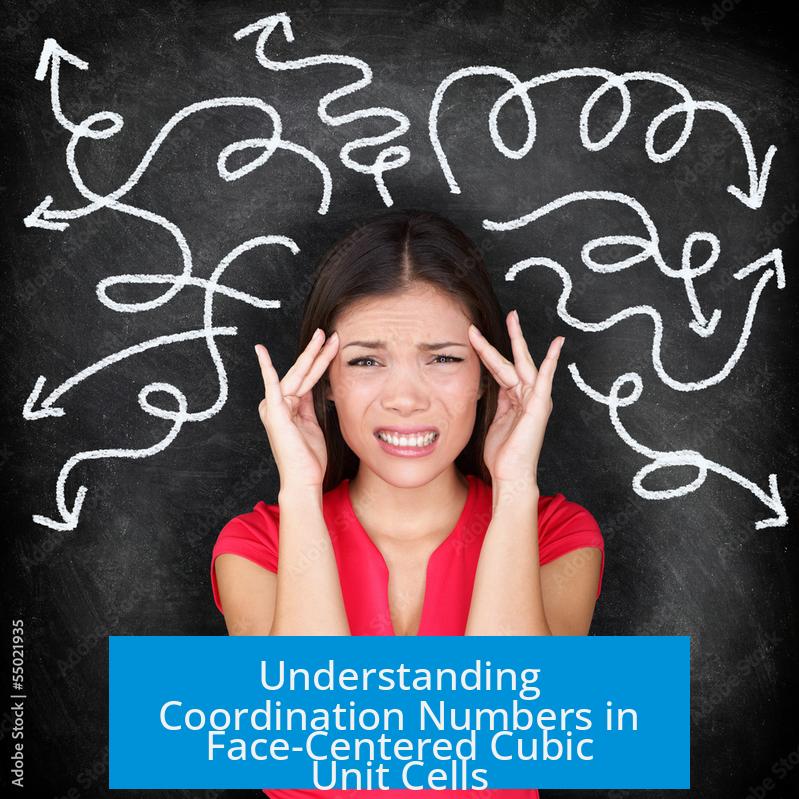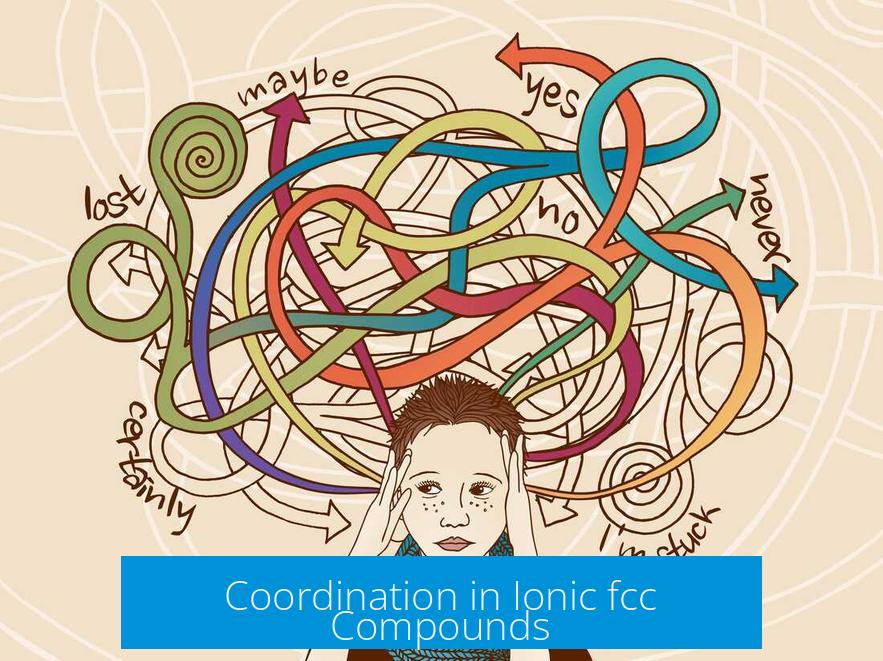Understanding Coordination Numbers in Face-Centered Cubic Unit Cells

The confusion about coordination numbers in face-centered cubic (fcc) unit cells arises mainly from differing definitions of coordination and the varying chemical contexts in which coordination is applied. Coordination number (CN) depends on whether we count immediate geometric neighbors or consider chemical bonding, including ionic charges and bond lengths.
Two Methods to Define Coordination Number
- Geometric coordination: Counting the nearest neighbors purely based on spatial proximity. This is common for elemental solids where all atoms are identical.
- Chemical coordination: Considering ionic charges and bonding distances, as in ionic compounds where ions attract oppositely charged ions within a certain radius.
Crystal Structure Versus Coordination Number
Crystal structure describes how atoms arrange in 3D space within the solid, often shown as an fcc lattice in many materials. Space group notation gives mathematical symmetry details but does not directly indicate coordination numbers.
For example, diamond and NaCl both crystallize in an fcc lattice (Pearson symbol cF8), but their space groups differ—diamond has an Fd-3m group, while NaCl has Fm-3m—leading to different coordination environments despite the common lattice type.
Coordination in Elemental fcc Metals
In elemental metals like alpha-aluminium, the fcc arrangement results in each atom having twelve closest neighbors. This number arises from the cuboctahedral geometry: six neighbors form a hexagon around the central atom, while two sets of three neighbors lie above and below it.
Coordination in Ionic fcc Compounds

In ionic salts such as NaCl, the coordination number differs due to the ionic nature of bonding. Each sodium ion in the fcc lattice is surrounded by six chloride ions, arranged octahedrally: four in the same plane, one above, and one below. This gives a CN of 6, reflecting chemical bonding rather than mere physical proximity.
Influence of Bond Lengths and Chemical Bonding
Coordination numbers can become complex when bond lengths vary and distorted structures occur. Atoms or ions that are not the absolute nearest neighbors may still count due to significant bonding interactions. The choice of coordination model depends on the chemical context and the method used for calculation.
This complexity means the pure geometric definition of coordination sometimes differs from the chemically realistic one.
Building Intuition on Coordination
Developing intuition about coordination numbers involves studying common examples and their crystal structures, such as metals, ionic salts, and covalent solids. Resources like the International Union of Crystallography provide standardized data to guide learning.
Memorizing coordination numbers for key materials helps apply chemical reasoning to unfamiliar cases.
Key Takeaways
- Coordination number depends on geometry and chemical bonding considerations.
- Elemental fcc metals typically have CN = 12; ionic fcc compounds like NaCl have CN = 6.
- Crystal structure (fcc) alone does not determine coordination number due to chemical variations.
- Bond lengths and ionic charges influence coordination in non-elemental compounds.
- Studying examples and reliable crystallographic data aids understanding and reduces confusion.
Confusion about Coordination Numbers in Face Centered Unit Cells: What’s Really Going On?

So, what’s the deal with coordination numbers in face centered cubic (fcc) structures? Why is there so much confusion? Let’s cut through the fog. The heart of the matter lies in what we mean by “coordination number.” It’s not some fixed mystical number but varies depending on how you look at it.
Face centered cubic (fcc) structures pop up everywhere in chemistry and material science. From silver and aluminum crystals to table salt, the face centered cubic lattice becomes the stage where atoms and ions dance. Yet, puzzlingly, when people try to talk about coordination numbers in these structures, confusion reigns supreme. Why?
Two Roads Diverged in Coordination: Geometry vs. Chemistry
The first snag comes from two different ways scientists express coordination. One method counts strictly the closest neighbors—the atoms that literally cozy up next door. This works perfectly for metals and elemental substances like alpha-aluminum or diamond. For example, in alpha-aluminum, each atom is hugged tight by twelve closest neighbors arranged in a neat cuboctahedron. It’s a crystal family reunion where everyone’s identical—no one’s feeling left out.
But here’s where it gets spicy. The other method drags bonding charges into the picture—think sodium ions and chloride ions in NaCl. Here, coordination takes into account electric charges and chemical bonds, not just who’s physically close. Sodium’s six chloride neighbors form an octahedron around it, not a crowd of twelve. This difference—nearest neighbors vs. bonding partners—is a cause of plenty of head-scratching moments.
Face Centered Cubic Isn’t a One-Trick Pony
We often hear “NaCl has an fcc structure,” and that’s true but slightly misleading. The geometry of the atoms sits on this beautiful face centered cubic lattice, but the chemistry is different. Diamond and NaCl both wear the fcc crystal structure hat, known as cubic, face-centered, with eight atoms per conventional cell (or cF8 in Pearson notation), yet their space groups differ.
Why care about this? Because the actual coordination number depends not just on the shape but on space group symmetries and atomic interactions. Diamond’s space group is F-d-3-bar-m while NaCl’s is F-m-3-bar-m, subtle mathematical differences that shape their bonding and, therefore, their coordination environments.
Counting Nearest Neighbors: Simple for Elements, Tricky for Compounds
In pure elemental solids, the answer looks straightforward. Alpha-aluminium is your textbook example with twelve nearest neighbors wrapping each atom in a cuboctahedral shell. This gives a coordination number of 12, no chemistry hats required.
Diamond, on the other hand, shows a tetrahedral coordination—a smaller crowd of four—because carbon atoms form strong covalent bonds differently than metals. Sometimes, the number itself tells a neat story about bonding in the solid.
The Ionic Twist: NaCl’s Octahedral Coordination

When we move to ionic compounds like NaCl, the game shifts. Sodium ions are surrounded by six chloride ions placed at the corners of an octahedron. Four chloride ions are in the same plane as the sodium ion, with one each above and below. This classic octahedral arrangement leads to a coordination number of 6 for Na+.
This result has a practical side. It reflects ionic interactions and charge balance rather than only spatial proximity. So, surprise! The fcc lattice doesn’t always neatly imply a “12 neighbors” story.
When Bond Lengths and Chemical Realities Complicate the Picture
But it’s not always this clear-cut. Real crystals aren’t perfect math problems; they have quirks. Bond lengths between ions can extend beyond immediate neighbors. Sometimes atoms that aren’t strictly closest geometrically get counted due to bonding effects.
This means coordination number calculations depend heavily on the chemical bonding model used, as well as how precisely one defines coordination. It’s a careful dance balancing pure geometry, algebraic symmetries, and messy chemical realities.
For instance, distorted crystalline structures or subtle differences in bond length can shift which atoms count as neighbors. So, a rigid geometric count might not fully capture the true chemical environment around atoms.
Building Intuition: From Memorization to Chemistry Insight
Confused yet? Here’s a handy tip: start small. Learn coordination numbers of well-known compounds like alpha-aluminium (12), NaCl (6), or diamond (4). This forms a foundation.
Then, lean on chemistry knowledge. Understanding ionic vs. covalent bonding, atomic sizes, and charge balance will help you extrapolate coordination in less common crystals. The International Union of Crystallography also offers excellent resources that build intuition over time.
Many seasoned chemists and crystallographers confess that their coordination number “calculator” is part memory, part intuition, and part snap judgment based on crystal and bonding knowledge.
Why Should You Care?
Knowing coordination numbers in the fcc unit cell is not just academic trivia. It affects how materials behave—mechanical strength, electrical conductivity, chemical reactivity, and more. Consider aluminum’s high coordination number contributing to its ductility, or NaCl’s arrangement influencing solubility and ionic conductivity.
Next time someone tells you an fcc structure always has coordination 12, ask: “Wait—do you mean strictly nearest atoms, or bond neighbors?” Understanding this nuance opens up a clearer picture of materials science.
Summary Table: Coordination Numbers in Face Centered Structures
| Substance | Structure | Nearest Neighbor Coordination | Chemical Coordination |
|---|---|---|---|
| Alpha-Aluminium | Face Centered Cubic (fcc) | 12 (cuboctahedron) | 12 (identical atoms) |
| Diamond (Carbon) | fcc lattice variant | 4 (tetrahedral) | 4 (strong covalent bonds) |
| NaCl | fcc lattice | 12 (geometric neighbors) | 6 (ionic coordination – octahedral) |
In essence, the “coordination number” isn’t a one-size-fits-all label. It’s more like a story where geometry, chemical bonding, and context shape the role each atom plays in the crystal theater.
So, next time confusion strikes, remember: coordination numbers reflect how you count neighbors. Are you counting chairs in a room (nearest atoms), or the people sitting in those chairs and their relationships (chemical bonds)? The face centered cubic unit cell plays host to both perspectives—and that’s what makes it so fascinating!
Q1: Why is there confusion about coordination numbers in face-centered cubic (fcc) unit cells?
Confusion arises because coordination can be counted two ways: by closest neighbors only, or by considering electric charges in bonding, as seen in compounds like NaCl. Different approaches yield different coordination numbers.
Q2: How does the coordination number differ between elemental substances and ionic compounds in an fcc structure?
In elemental fcc crystals like alpha-aluminium, coordination counts all closest identical atoms, usually 12 neighbors. For ionic compounds like NaCl, coordination focuses on ions and charge balance, typically showing 6 neighbors due to ionic bonding.
Q3: What role does bond length play in determining coordination numbers?
Bond length complicates coordination count. Sometimes atoms that are not closest neighbors are counted to reflect actual chemical bonding. The model chosen for bonding affects whether distant atoms contribute to the coordination number.
Q4: Can two substances with the same crystal structure have different coordination numbers?
Yes. For example, diamond and NaCl both have fcc crystal structures but differing space groups and bonding. Diamond’s coordination involves identical atoms, while NaCl’s depends on ion interactions, resulting in different coordination numbers.
Q5: How can one approach understanding coordination numbers practically?
Building intuition through examples helps. Learning conventions from sources like the International Union of Crystallography provides clarity. Memorizing common compounds and applying chemistry knowledge aids in extrapolating coordination numbers correctly.





Leave a Comment